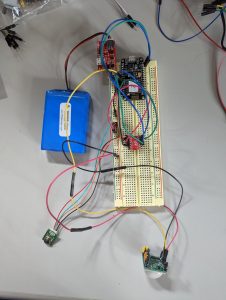This week, I worked on two things. First, I helped finalize the final presentation and watched other groups’ presentations (which were all great)! Second, and more importantly, I did a lot of power testing for the system. Specifically, I tested the power draw of both sensors, as well as the power draw of the system with different code/states running (including no optimizations, delay statements between loops, and deep sleep). Unfortunately, I ran into a big issue in that the processor was consuming far more power than specified by the datasheet. While the datasheet rated the processor in deep sleep consuming only 10uA of current, the measured system current consumption in deep sleep was consistently 14.6mA, a factor of 1000x higher than expected. This included the PIR sensor consuming around 50uA of current (regardless of state) and the thermal sensor consuming around 5mA of current (regardless of state), so the processor is still consuming much more than we had accounted for. With all this being said, our battery should only last about 82/107 hours required by our use case. This creates a clear risk to our design meeting our use case which I will outline more in the team status report.
Next week, I plan on completing a couple of battery tests to confirm that the battery will not last its full duration. In addition, I will finish out the semester by finalizing our poster, doing some fine-tuning on thresholds of the occupancy algorithm for Weigand Gym, and turning in the final report. I am more or less on schedule — I am adding in some confirmation battery tests to tie a bow on the power testing which would have been nice to have done by now, but I shouldn’t have a problem getting those in for the final report.


